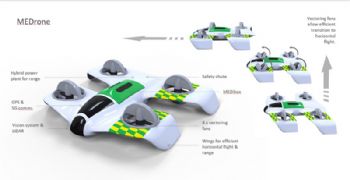
Medical students who won UK Space Agency funding to develop a drone that can deliver medical supplies in emergencies and to remote areas are ‘flying high’ after receiving help from the AMRC (
www.amrc.co.uk) to create concept designs.
Thomas Franchi (University of Sheffield), Hammad Jeilani and Chris Law (both Barts and the London School of Medicine and Dentistry) set up the company MEDeus to create their drone and medical box system, MEDrone and MEDiBox respectively.
The two systems are designed to complement each other to deliver medical items between GP services, hospitals and NHS Trusts in rural and congested city locations and for a range of missions — from carrying blood samples and emergency medical equipment such as defibrillators to life-saving organ transplants.
MEDeus asked the AMRC’s Design and Prototyping Group (DPG) for CAD and early-stage graphical design assistance for the drone.
They worked with senior project engineer Samuel Rees and principal engineer Garth Nicholson, who built on the research provided by MEDeus to produce a series of still images that could be collated in a ‘storyboard’ format to illustrate the drone’s potential applications.
Mr Rees said: “Prior to us helping, they had a document that explained the problems they were trying to overcome and the solutions they had developed.
"It had a few diagrams in it, but it was very wordy and didn’t have the necessary visual impact or tell the story in a particularly compelling way.
They had envisaged a quadcopter as the type of drone they wanted to use, so we worked through some concept designs we thought would best suit the applications proposed for the MEDrone.”
The main challenge was to have a drone that can travel over long distances efficiently and economically and then land easily in difficult terrain or close to buildings. Samuel and Garth came up with an innovative solution that incorporated fans in the tandem wings.
Mr Rees said: “A wing design with the fans in the wings allows a principle called ‘blown wing’ to occur, with the forced airflow over a wing generating lift. This design also has vectoring fans, so it can transition from vertical flight to horizontal flight.”